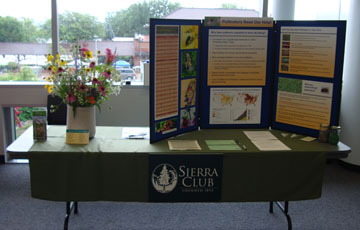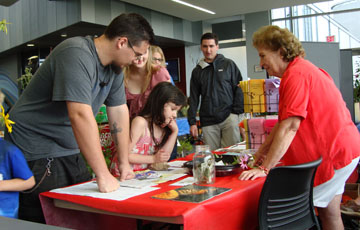July 2015

The Peoria Riverfront Museum and the Heart of Illinois Sierra Club cosponsored “Monarch Butterflies and other Pollinators Day” July 11th at the Riverfront Museum, from 12 to 4 p.m. Attendance was noticeably larger than last year's event, possibly due to the fact that it was a rainy day and the event coincided with the opening of the Dinosaurs in Motion exhibit, just a few steps from the Pollinators Day event.
Displays by participating organizations covered ways to make your yard pollinator friendly, which included planting native plants and building bee nesting blocks. Vendors offered a variety of native plants for sale. One exhibit had live monarch caterpillars eating milkweed leaves, which totally fascinated all the kids. Equally astonishing, during the event a monarch butterfly emerged from it's chrysalis for all to see! A couple of hands-on classrooms were also available to help kids learns more about pollinators.
The HOI Group display focused on reasons for the decline in pollinator populations, including:
- Increased use of glyphosate herbicide on GMO “Roundup-ready” crops
- Skyrocketing use of new neonicotinoid pesticides
- More acreage planted in corn and soybeans
- Rapid transfer of parasites and diseases of pollinator species around the world
- Loss of habitat and changes in seasonal behavior due to global warming

We displayed jars of corn and soybeen seeds coated with neonicotinoid pesticides, which are systemic pesticides, taken up by the plant and transported to all the tissues (leaves, flowers, roots and stems, as well as pollen and nectar). Very low levels of neonicotinoids can disrupt bee learning and the ability to forage for food and so limit colony growth. 95% of corn seed and over 40% of soybean seeds are treated with neonicotinoids, which were first introduced in the 1990s. Neonicotinoids can also be found in a wide variety of home and garden products which are applied in concentrations exceeding their agricultural use.
We also included ways to help pollinators in your yard, provided a list of native plants attractive to pollinators, and displayed an arrangement of 18 currently flowering native plants.
